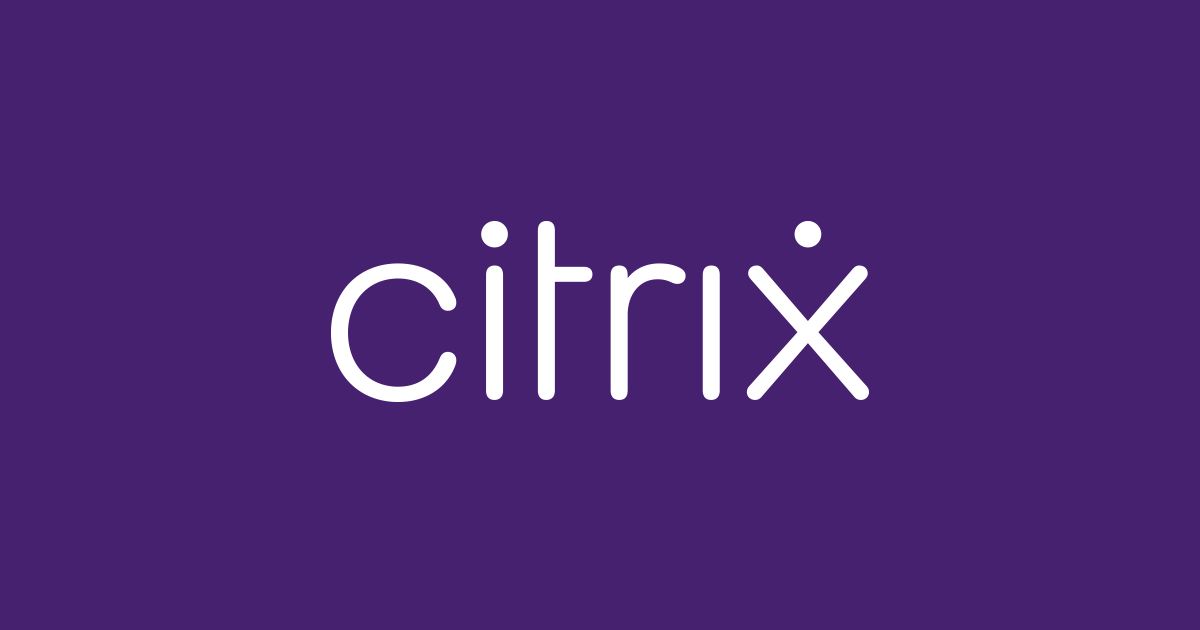- Citrix Receiver vs Citrix Workspace App. Citrix Workspace app is an easy-to-install client application that provides secure and seamless access to your apps, files, and desktops. It is free to download and use. Citrix Workspace app allows you access from various devices, including smartphones, tablets, and Windows or Mac computers.
- On the Citrix online store, you can buy Citrix Workspace, App Delivery & Security products, or learn about our products, subscriptions and request a quote. Download Citrix Workspace app Citrix Workspace app is the easy-to-install client software that provides seamless secure access to everything you need to get work done.
- In the November 2017 there is the latest version of Citrix 4.9. I have downloaded it working nicely on my Windows. Have anyone issues with Citrix V4.9?
The Citrix infrastructure is notoriously complex. Determining the cause of a seemingly simple issue can take a great deal of time. Outdated Version of Citrix Receiver. Sometimes the problem can be as simple as having an outdated version of Citrix Receiver. This can be avoided by making sure all users have the latest version. With this release, Citrix Workspace app introduces an option to disable the storing of authentication tokens on the local disk. For enhanced security, we now provide a Group Policy Object (GPO) policy to configure the authentication token storage. Microsoft Teams enhancements 4. The VP9 video codec is now disabled by default.
To configure Single Sign-on on a new setup:
1. Enable User name and password and Domain pass-through on StoreFront or the Web Interface
Depending on the XenApp/XenDesktop deployment, Single Sign-on authentication can be configured on StoreFront or the Web Interface using the Management Console.
StoreFront server: Launch StoreFront Studio, go to Store > Manage Authentication methods > enable Domain pass-through.
Note: Single Sign-on is not supported if Citrix Receiver for Windows is connected to XenApp/XenDesktop using NetScaler Gateway.
| Scenario | Steps | Description |
|---|---|---|
| Configured on StoreFront or the Web Interface with Management Console | StoreFront server: Launch StoreFront Studio, go to Store > Manage Authentication methods > enable Domain pass-through. | When Citrix Receiver for Windows is not configured with Single Sign-on, it automatically switches the authentication method from Domain pass-through to Username and Password, if available. |
| Receiver for Web IS Required | Launch Stores > Receiver for Websites > Manage Authentication methods > enable Domain pass-through. | When Citrix Receiver for Web is not configured to allow Domain pass-through, it automatically switches the authentication method to Username and Password, if available. If you are launching published applications using web browsers for Storeweb, enable the Single Sign-on feature as described in the sectionGroup Policy Settings. |
| StoreFront IS NOT configured | If Web Interface is configured on a XenApp server, open XenApp Services Sites > Authentication Methods > enable Pass-through. | When Citrix Receiver for Windows is not configured with Single Sign-on, it automatically switches the authentication method from Pass-through to Explicit, if available. |
2. Configure XML trust services on the Delivery Controller
On XenDesktop 7 or later or XenApp 7.5 or later, run the following PowerShell command as an administrator on the Delivery Controller:
asnp Citrix*
Set-BrokerSite -TrustRequestsSentToTheXmlServicePort $True
Refer to the Knowledge Center article: Error: 'An error occurred while making the requested connection'.
Note: On XenApp 6.5, XML Service Port and Trust is enabled using the Graphical User Interface. For more information, see Configuring the Citrix XML Service Port and Trust.
3. Modify Web Browsers settings and Install Citrix Receiver for Windows with Single Sign-on
3.1 Modify the web browsers settings
3.1.1 Configuring IE, Chrome, Edge browsers and Citrix Workspace for Windows for Single Sign-on
Modify the Internet Explorer settings to add StoreFront URL or Web Interface URL to the list of Security Zones in Internet Options. There are two methods to modify Security Zones:
NOTE: At any time, use only one of the following methods.
| Option 1 |
|---|
|
| Option 2 |
|---|
Note: Automatic logon with current user name and password can be configured using Group Policy. For more details, see Managing Browser Settings with Group Policy Tools. |
3.1.2 Configuring Firefox for Single Sign-on

- Open Firefox
- Type about:config in the address bar
- A security warning page will appear. To continue, click “I accept the risk!”
- List of configurations will be available. In the search bar type “network.automatic-ntlm-auth.trusted-uris” and add the store URL to that configuration
3.2 Install Citrix Receiver for Windows
- Download Citrix Receiver for Windows (CitrixReceiver.exe) from Citrix Downloads.
- Log onto the client device with administrator privilege.
- You can install Citrix Receiver for Windows in two ways:
Using the Graphical User Interface Using the Command Line Interface - Double-click CitrixReceiver.exe.
- In the Citrix Receiver Installation wizard, select Enable Single Sign-on.
- Click Next.
- After the installation is complete, log off from the client device and log on again.
- Open a command prompt as an administrator and change to the directory to where CitrixReceiver.exe is located.
- Run the following command to install Citrix Receiver for Windows with the Single Sign-on feature enabled:
CitrixReceiver.exe /includeSSON /silent
- After the installation is complete, log off from the client machine and log on again.
- Launch the Task Manager to verify that the ssonsvr.exe process is running.
Users should now be able to log on to an existing Store (or configure a new Store) using Citrix Receiver for Windows without providing credentials.

Group policy settings
Configuration described in this section is required in two cases:
• When access to StoreWeb using web browsers is required.
• Citrix Receiver for Windows version 4.3 or earlier is used.
For newer versions of Receiver (4.4 onwards) that do not require SSON via web browsers, the configuration is optional
Using Citrix Receiver for Windows Group Policy template files
• Add Citrix Receiver for Windows template files to the Local Group Policy Editor. For more information, see Configure Receiver with the Group Policy Object template . Be sure to use the ADM template of the same version as the Receiver on the Client.Follow the below steps to configure the policy
1. Open Local Group Policy Editor. Navigate to Citrix Receiver > User authentication.2. Open the Local user name password policy.
3. Select Enable pass-through authentication.
4. Click Apply and OK.
Note: If the existing version of Citrix Receiver for Windows does not have the Single Sign-on component installed, upgrading to the latest version with the /includeSSON switch is not supported.
After the installation is complete, log off from the client device and log on again.
Single Sign-on Diagnostics
In Citrix Receiver for Windows Version 4.5, you can use Configuration Checker to diagnose the Single Sign-on configuration.
Right-click the Citrix Receiver icon in the notification area and select Advanced Preferences > Configuration Checker.
The Configuration Checker window appears.Select SSONChecker and click Run.
The test runs on all the SSON checkpoints.
After the test is complete, the results are displayed for each test.
The test describes if all the configuration requirements for Single Sign-on are met.
For more information, see Using Configuration Checker to validate Single Sign-on configuration
Verify the list of Network Providers
If users face any issues with Single Sign-on, Citrix recommends that you verify the list of network providers list on the client machin e as described below:
Click Start.
Enter View network connections. The Network Connection window appears.
Press ALT to display the menu. Click Advanced > Advanced Settings
Advanced Settings window appears.Click the Provider Order tab.
Move “Citrix Single Sign On” to the top of the list to change the order of network providers.
Additional Resources
| Version Number | Release Date |
| 4.00 | September, 1998 |
| 4.20 | June, 1999 |
| 4.21 | December, 1999 |
| 6.00 | September, 2000 |
| 6.01.963 | November, 2000 |
| 6.01.964 | January, 2001 |
| 6.01.964 | March, 2001 |
| 6.20.985 | September, 2001 |
| 6.30.1050 | September, 2002 |
| 6.31.1051 | October, 2002 |
| 7.00.17534 | June, 2003 |
| 7.01.20497 | June, 2003 |
| 7.10.22650 | November, 2003 |
| 7.100.21825 | October, 2003 |
| 8.00.24737 | April, 2004 |
| 8.100.29670 | October, 2004 |
| 9.00.32649 | April, 2005 |
| 9.100.36280 | October, 2005 |
| 9.150.3915 | December, 2005 |
| 9.200.44376 | May, 2006 |
| 9.230.50211 | November, 2006 |
| 10.000.52110 | March, 2007 |
| 10.100.55836 | June, 2007 |
| 10.150.58643 | November, 2007 |
| 10.200.02650 | March, 2008 |
| 11.000.5323 | June, 2008 |
| 11.0.0.5357 | September, 2008 |
| 11.0.150.5357 | November, 2009 |
| 11.1.0.19460 | February, 2009 |
| 11.2.0.31560 | September, 2009 |
| 11.2.2.3 | July, 1905 |
| 12.0.0.6410 | March, 2010 |
| 12.0.3.6 | August, 2010 |
| 12.1.0.30 | November, 2010 |
| 12.3.0.8 | April, 2012 |
| 13.0.0.6685 - Receiver 3.0 | August, 2011 |
| 13.1.0.89 - Receiver 3.1 | December, 2011 |
| 13.1.100.05 - Receiver 3.1 | February, 2012 |
| 13.1.200.22 - Receiver 3.2 | June, 2012 |
| 13.1.201.3 - Receiver 3.2 | June, 2012 |
| 13.1.300.8 - - Receiver 3.2 CU 1 | June, 2012 |
| 13.3.0.55 - Receiver 3.3 | July, 2012 |
| 13.3.100.9 - Receiver 3.3 CU1 | October, 2012 |
| 13.4.0.25 - Receiver 3.4 | December, 2012 |
| 13.4.100.7 - Receiver 3.4 CU 1 | March, 2013 |
| 13.4.200.11 - Receiver 3.4 CU 2 | July, 2013 |
| 13.4.300.10 - Receiver 3.4 CU 3 | January, 2014 |
| 13.4.400.09 - Receiver 3.4 CU 4 | December, 2014 |
| 14.0.0.91 - Receiver 4.0 | June, 2013 |
| 14.0.1.4 - Receiver 4.0.1 | September, 2013 |
| 14.1.0.0 - Receiver 4.1 | October, 2013 |
| 14.1.2.3 - Receiver 4.1.2 | January, 2014 |
| 14.1.100.12 - Receiver 4.1 CU 1 | June, 2014 |
| 14.1.200.13 - Receiver 4.1 CU 2 | September, 2014 |
| 14.2.0.10 - Receiver 4.2 | December, 2014 |
| 14.2.100.14 - Receiver 4.2.100 | April, 2015 |
| 14.3.0.5014 - Receiver 4.3 | June, 2015 |
| 14.3.1.1 - Receiver 4.3.1 | August, 2015 |
| 14.4.0.8014 - Receiver 4.4 ( LTSR ) | December, 2015 |
| 14.5.0.10018 - Receiver 4.5 | September 2016 |
| 14.6.0.12010- Receiver 4.6 | December 2016 |
| 14.7.0.13011-Receiver 4.7 | March 2017 |
| 14.8.0.1010- Receiver 4.8 | June 2017 |
| 14.9.0.2539 Receiver 4.9 ( LTSR ) | August 2017 |
| 4.9.1000.17 Receiver 4.9 LTSR CU1 | November 2017 |
| 4.9.2000.21 Receiver 4.9 LTSR CU2 | March 2018 |
| 4.9.3000.11 Receiver 4.9 LTSR CU3 | Jun 2018 |
| 14.10.1.22 - Receiver 4.10.1 | January 2018 |
| 14.11.0.17061 - Receiver 4.11 | February 2018 |
| 14.12.0.18020 - Receiver 4.12 | June 2018 |
| 4.9.4000.9 Receiver 4.9 LTSR CU 4 | August 2018 |
| 4.9.5000.7 Receiver 4.9 LTSR CU 5 | Dec 2018 |

For Citrix Workspace App version list, please review the Lifecycle page here: https://www.citrix.com/support/product-lifecycle/milestones/receiver.html
Note: This list includes only public Citrix Receiver for Windows releases (formerly known as the Presentation Server ClientPlug-in) , therefore, private and Original Equipment Manufacturer (OEM) Client Plugins are not listed. Also XenDesktop clients are not listed.
Additional Resources
Citrix Workspace App 2107 For Windows - Citrix
- CTX201614 - How to Use the Citrix Scout utility to gather client version information for XenApp
CTX200322 - Additional Lifecycle Information for Citrix Receiver for Windows
CTX200326 - Additional Lifecycle Information for Receiver for Mac
For the latest available list of Citrix Receiver and Plug-ins, click here.